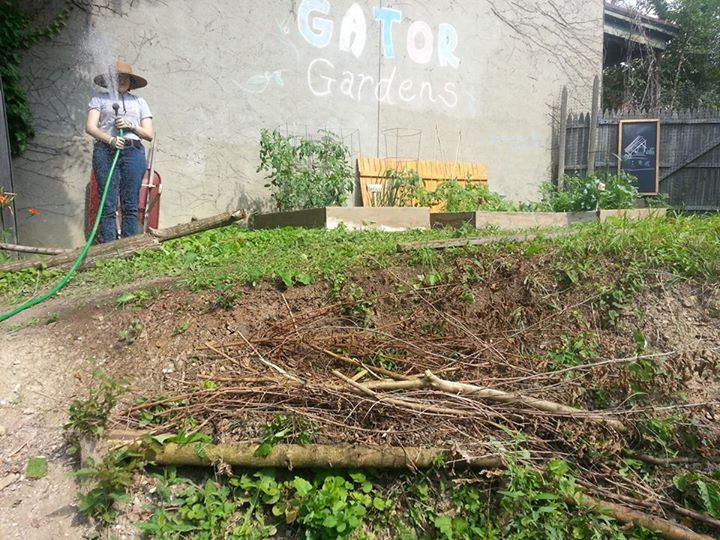Erosion Control
Erosion control through experimental permaculture can save a steep bank from eroding away. We did just that in a tight space where we couldn't change the angle very much, maybe one below a road bed or some other already built up area where you can't loose any more soil without risking collapse? There are a few ways you could address it. Nearly all of them require money, machinery, and some amount of engineering. What's more most of those will eventually fail leaving you in a similar situation or possibly worse. Too those meant to last the longest often will fail the most spectacularly and will probably cost the most both to initially install and to maintain. There has to be a better way and there is.
Natural Erosion Control
So how can we control erosion naturally? We need to study how nature does it. On steep slopes in the forest a tree will fall even before it dies if erosion eats away the soil around it. When a tree falls on a steep slope it will usually be caught by stumps from previous fallen trees or by clumps of woody undergrowth, it's own branches, etc. which will prevent it from rolling to the bottom of the slope. As it decomposes where it fell leaves and debris will pile around it and it will eventually serve as a catch preventing or at least slowing erosion in the area where it fell.
Swales & Hugelkultur
By now, if you're familiar with permaculture you're saying - why not use a swale? If you're not familiar with them swales are contour ditches that help infiltrate water into the landscape. They're fantastic at preventing drought and flash flooding, at rehydrating the landscape, at reducing the amount of water needed to be put onto plants and gardens via pumping, they refill the aquifer, and provide balance in nature. They're really remarkable. That being said they won't work if the slope you're working on is too steep because the downhill side of the swale will need to be even steeper than the slope itself was leading to it's own erosion at a much faster rate. Hugelkultur mimics what the forest does when a tree falls It's primarily employed as a means of creating soil that holds vast amounts of water and creating soil that, do to being in a state of active decomposition, is warm, allowing for a longer growing season. It does this because logs are usually somewhat rotted before they're used, then a bit of a ditch is dug, the log/logs are placed inside of this ditch, soil and compost is piled on top and cover crops are sewn on the soil. Hugelkultur is a great way to slow the flow of water on a slope but like with swales it's usually used on mild slopes because the downhill side could never be expected to retain the soil piled on top of it on the type of slopes we're talking about. If we're on a steep slope that is surrounded by grass or little vegetative growth, (not a forested landscape), maybe one with compacted, hard-pan soil above it adding to the difficulty how do we tweak the swale and hugelkultur ideas to make them work?.
Raw Hugelkultur
To achieve stabilization and because the slopes we're talking about are really too steep to expect soil placed on the down-slope side of a log or swale to stay in place we need to go back and look at nature and mimic what happens in nature on steep slopes. There nature piles loose debris, compost, some soil, etc on the back or uphill side of the log/logs but not on the front (where it won't stick). Will this work on a steep slope outside of the forest where the soil has died and won't hold vegetation? It should so we've decided to test it.
Our Stabilized Steep Slope Experiment
Lets look at an example. This is a steep slope that is located in a community garden in Garfield. There are raised garden beds above and below it, the slope has seen a great deal of erosion and was in need of some emergency care to make sure it didn't fail completely. Here is a photo of the slope:

As you can see it does have some vegetation but it's not enough. The slope is eroding around this vegetation. In spots it's already eroded back to rock. Worst still is the fact that this bank is fill and not a cut into a natural slope so the soil behind it is likely not very stable.
The photo below shows the area to the right of the previous picture. The slope in general ranges from about 40 degrees to as much as 65 or even 70. None of it is less than 45 degrees.

Raw Hugelkultur
Here is how we are seeking to solve the problem. We've used small logs from the site, from a tree that was removed. I wasn't able to identify it but it was likely a pioneer species that took root in this abandoned lot some time ago. We used what was on site which I personally feel is the best option. The gardeners who cleared the lot had simply removed this tree and were letting it decompose out of the way so why not put it to use in the landscape?

We used a few old stumps as our stakes. The log was placed behind it, in hindsight we should have excavated some of the soil so it would sit flush but we put some smaller logs behind it, covered those with compost, added some soil and piled some debris from the downed tree (small branches, twigs, leaves, etc) on top. Just like with hugelkultur the log will decompose but probably not very rapidly and the front or downhill side will last the longest as it's facing south and has little to no shade so it's not going to be a popular place for fungi to grow. Lastly we added some grass and clover clippings that came from the abandoned lot across the street. These have gone to seed and those seeds may help to establish some growth on the top which will further help with erosion control. Too the carbon in the log and branches should be balanced out with some nitrogen and the greens from what we threw on top there will help with that but really the clover (if it takes hold) will help fix nitrogen. There's another reason we added this debris. Though the compost is alive it's alive mostly with microbes which will eventually break down the woody material but they really can't get started until there is some fungus. All of these but fungus more so need shelter from the sun and living soil in which to operate. Since the soil on the slope had been baked by the sun and was almost certainly devoid of microbial life we needed to provide a shelter where water can get in but where the sun is kept out - just like on the forest floor. This debris will also help slow the water that will run across the area and that will fall like rain.
Testing Raw Hugelkultur
Will it work? Only one way to tell - to tested it.

We simulated rain directly on the top of the area. We did this for over 5 minutes. Clearly this isn't a true test but this was municipal water so we didn't want to use a lot of it. They're working on capturing water onsite but for now they're exclusively using municipal water to water the beds.
You can see that the raw soil above the site is saturated, some of the soil has started to run down the hill but has stopped at the uphill side of the log. Below the grown is still dry. The slope below the logs should not erode at the same rate that it was because only the rain falling directly on it will continue to erode it. There is a rose of Sharron bush growing around the stumps we placed the log against and another below, near the middle of the log and some other vegetation. This all should help keep the downhill side from eroding as fast. Too I've suggested that they consider changing the degree of the slope here (where there is some room to do so) and that they plant a small fruit tree there which will help not only the area below but also above (in that less rain will fall on it).
Long Term Results
Will this work long term? Honestly I don't know but in the end it can probably be redone in a few years if it fails. The worse that will happen on this test site is that the log will rot away and the rich organic soil we're creating from it may run downhill. Some of it may dry out and die but if we're willing to go back and do this experiment again we're only loosing the new material we're adding and not the hillside itself. That might not seem like such a great deal (needing to redo it in 3-5 years) but the alternative is spending a large sum of money and fuel and needing to continuously fight against nature to do what nature can do on it's own given the tools to do it. Too our process sequesters carbon, we've used no fossil fuels (the tree was cut by hand), and there is a chance we might not have to redo it especially if the folks who use the garden decide to plant trees or herbaceous plants on the slope once there is soil there to do it. I'll do my best to post some follow-up posts about it in the future. Please feel free to ask any question or post alternative ideas in the comments.
Sony a7R IV Mirrorless Full Frame Camera Body + 50mm F1.8 FE Fast E-Mount Lens SEL50F18F ILCE-7RM4A/B Bundle with Deco Gear Backpack + Microphone + LED + Monopod and Accessories Kit
Now retrieving the price.
(as of November 16, 2025 22:56 GMT -05:00 - More infoProduct prices and availability are accurate as of the date/time indicated and are subject to change. Any price and availability information displayed on [relevant Amazon Site(s), as applicable] at the time of purchase will apply to the purchase of this product.)





You must be logged in to post a comment.